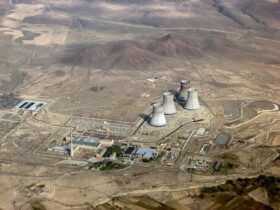LOS ANGELES — The 2021 United Nations Climate Change Conference (COP26), being held in Glasgow, UK, this fall, has the international community gearing towards monumental strides against climate change. This year’s COP is of notable importance for several reasons. It is the first COP since 2020, when all countries had to submit their new long-term goals to address global climate change. It is also the time to finish what was started at COP25 in 2019, before the pandemic. Most importantly, it is a crucial opportunity to get back on track with the 2015 Paris Climate Accords, especially with the United States’ re-entry into the agreement.
Although climate discussions consistently focus on emission reduction and carbon markets, COP26, in particular, aims to advance much-needed progress in energy policy. Globally, the energy sector contributes over two-thirds of greenhouse gas emissions. Moreover, while the energy sector exacerbates climate change, worsening conditions from climate change have detrimentally impacted energy industries in developing countries, affecting water access, transport, and other industry mechanisms. As a result, energy will be a focus area for climate policymakers in Glasgow.
The organizational framework of COP26 can be best understood through four categories: mitigation, adaptation, finance and collaboration.
Mitigation
The global community is currently not on track to limit global warming to 1.5 degrees Celsius, the warming target outlined in the Paris Agreement. Instead, based on current estimates, warming is projected to be well above 3 degrees Celsius by 2100. In order to prevent catastrophe, the world must halve emissions over the next decade and reach net-zero carbon emissions by 2050 to prevent rampant global temperature increases.
COP26 will re-emphasize the importance of nationally determined contributions. According to the Paris Agreement, every country agreed to share and update their emissions reduction targets every five years. 2020 was the end of the first of these five-year cycles, and countries will be entering the conference with updates for their 2030 targets. It is essential for developed countries, the largest emitters, to take the lead on critical action items to reduce emissions: accelerating the transition away from coal, encouraging investment in renewables, protecting and restoring nature by halting deforestation and pushing towards zero-emission vehicles.
However, national efforts to assuage the onslaught of climate change must begin with mitigation tactics to reduce each nation’s contribution to greenhouse emissions.
Adaptation
Despite mitigation efforts, climate change has already had a devastating impact worldwide, and further change is inevitable. Each country is supposed to produce an adaptation communication, summarizing how they plan to adapt to impacts of climate change and where they need help. A key action item involves planning and financing for improving and building early warning systems, flood defenses, resilient infrastructure and agriculture. Specifically, in the energy sector, initiatives will pertain to constructing renewable energy systems to promote energy transition and reduce energy poverty in the developing world.
These adaptation strategies should focus on supporting vulnerable populations that are particularly susceptible to the impending impact of climate change. As countries develop their adaptation communication, each plan should foreground high-risk communities in flood zones and on shorelines, directly in the path of climate change without adequate defense.
Finance and Collaboration
Significant progress cannot occur without finance and multilateral collaboration. Energy development requires all forms of finance: public finance to develop infrastructure and private finance to fund technology, innovation and climate investment. It is here where developing countries need as much additional support as possible. At COP26, developing countries will push for developed countries to deliver on the promise to raise at least $100 billion annually in climate finance to support clean development.
Climate NGOs and activists will also advocate for considering a net-zero transition in financial decisions, even in private investment and all spending for pandemic stimulus packages and economic rebuilding. In addition, ey financial actors such as central banks and the private sector (banks, insurers, investors and financial firms) should work towards greater transparency and align this shift to net-zero emissions.
The broad cooperative goals of COP26 are to finalize the Paris Rulebook and work together towards Action Items. For the rulebook, countries will seek to find a solution on carbon markets with carbon credits that support the net-zero transition, resolve transparency issues by creating a universal system to promote keeping national commitments and broker an agreement that drives governments to focus on the 1.5 degree Celsius goal.
Multilateral coalitions have already been formed to address key energy concerns, and COP26 will be a critical platform to showcase and further their work.
To meet the Paris Agreement’s goals, the movement away from coal and towards clean power needs to be 5x faster than current efforts. Fortunately, solar and wind power are now cheaper than coal in most countries. The Energy Transition Council and Powering Past Coal Alliance have already begun facilitating this. With membership from the World Bank, International Energy Agency (IEA), among others, the Energy Transition Council works to ensure clean power is the most viable option for the new power generation. This involves supporting countries in making an equitable transition away from coal. Similarly, the Powering Past Coal Alliance is an international public-private partnership aiming to phase out coal power and end international financing of coal plants.
COP26 can amplify these coalition’s initial steps by pledging to restrict the construction of new coal plants and phase out coal power entirely by 2030 in developed countries and 2040 in developing countries. While ending coal power, countries should help scale up clean power by encouraging investment into renewables and increasing energy efficiency.
The RE100 initiative, led by the Climate Group, unifies influential businesses committed to 100% renewable energy in the private sector. With over 300 members in 175+ markets, they are already driving 300+ TWh/yr in renewable energy. The Climate Group also enables energy-smart companies to improve energy productivity through the EP100 initiative, lowering global energy demand and accelerating the clean energy transition. This is in conjunction with the IEA’s initiative between 19 member governments to address global energy challenges and promote energy efficiency worldwide. The group seeks to increase transparency and identify best practices and opportunities for cooperation.
Putting It All Together
Successful buy-in into these multilateral initiatives requires global powers to lead at COP26. The United States, with its re-entry into the Paris Climate Accords and the Biden/Harris Climate Goals, is set to do just that.
The current administration’s climate goals, ranging from net-zero transition, mobilizing climate finance, transforming energy and transport systems and creating adaptation mechanisms, align directly with the main objectives of COP26. The conference will provide a forum for the United States to pioneer new multilateral initiatives and serve as an opportunity to demonstrate commitment to combating climate change and restoring public trust after the previous administration’s withdrawal from the Paris Agreement.
COP26 can tackle climate change and meet key goals with clearly defined objectives, multilateral cooperation and strong leadership. In the energy sector, discussions must prioritize reducing emissions by prioritizing energy transition and investment into renewable energy, aiming to reach net-zero emissions by 2050 and ending energy poverty in the developing world.
The United States, along with other developed nations, as the largest emitters have an obligation to not only lead but also support developing nations in reaching their targets. COP26 is the “world’s best last chance” for meaningful climate action, and energy sector reform is essential to save the planet before it is too late.






